Can You Make A Bobcat A Pet? Absolutely not, owning a bobcat poses significant challenges and risks. PETS.EDU.VN explores why these wild animals are unsuitable as pets and introduces domestic cat breeds that offer a similar exotic look without the inherent dangers. Understand the complexities of bobcat ownership and explore alternative feline companions with PETS.EDU.VN.
1. Understanding the Wild Nature of Bobcats
The bobcat (Lynx rufus), a captivating wild cat species, naturally roams North America. These felines, recognizable by their spotted coats and tufted ears, often draw comparisons to domestic cats. However, despite their visual similarities, significant differences exist. Male bobcats typically weigh around 20 pounds, but can reach up to 40 pounds, while females average about 15 pounds, with a maximum weight of 33 pounds.
Many people consider bobcats as potential pets when they are young, believing they can be tamed if raised correctly. While owning a wild cat might seem exciting, it’s crucial to understand whether bobcats truly make great pets. The general consensus is no, and it’s essential to delve into the distinctions between wild and domestic cats to understand why bobcats are less suitable as pets.
2. Wild Cats vs. Domestic Cats: A Critical Comparison
All cats, whether wild or domestic, belong to the Felidae family. This family is further divided into two subfamilies: Pantherinae and Felinae.
- Pantherinae: This subfamily includes seven big cat species classified into the Panthera and Neofelis genera. The Panthera genus consists of the lion (Panthera leo), tiger (Panthera tigris), jaguar (Panthera onca), leopard (Panthera pardus), and snow leopard (Panthera uncia). The Neofelis genus includes the mainland clouded leopard (Neofelis nebulosa) and Sunda clouded leopard (Neofelis diardi).
- Felinae: This subfamily includes various smaller wild cat species, such as the African wildcat (Felis lybica), Asian golden cat (Catopuma temminckii), bobcat (Lynx rufus), caracal (Caracal caracal), cheetah (Acinonyx jubatus), cougar or mountain lion (Puma concolor), jungle cat (Felis chaus), leopard cat (Prionailurus bengalensis), ocelot (Leopardus pardalis), and serval (Leptailurus serval). Our domestic cat (Felis catus) also belongs to the Felinae subfamily.
A key difference between these subfamilies lies in their vocalizations. Except for the snow leopard, all Pantherinae members can roar but cannot purr. Conversely, Felinae members can purr but cannot roar. This difference is due to the flexible hyoid bone in the throat of Pantherinae cats, compared to the bony hyoids in Felinae cats.
3. The Genetic Relationship Between Bobcats and Domestic Cats
As members of the same subfamily, Felinae, bobcats and domestic cats share a degree of relatedness. This might lead some to believe that bobcats can be easily tamed and integrated into households. However, it’s essential to remember that the Felinae subfamily also includes cheetahs, cougars, and caracals, which are clearly unsuitable as house pets, despite their relation to domestic cats.
While bobcats and domestic cats are related, they exhibit significant differences. Instances of bobcats mating with domestic cats have been reported, but documented offspring are nonexistent. This suggests that interbreeding between the two species is unlikely.
4. Why Bobcats Do Not Make Good Pets
Despite stories of individuals rescuing and raising bobcat kittens as pets, wildlife educators strongly advise against this practice for several compelling reasons.
4.1. Unpredictable and Dangerous Behavior
Bobcats, whether in the wild or raised in a home, remain unpredictable and potentially dangerous. As wild animals, their instincts can surface unexpectedly, leading to aggressive behavior.
Even bobcats raised by humans from kittenhood can exhibit their wild side. These animals possess powerful jaws and sharp teeth and claws. A single bite or swipe can cause severe injuries. According to the Humane Society, wild animals kept as pets pose safety risks due to their unpredictable nature.
4.2. Territorial and Destructive Habits
Bobcats are highly territorial and exhibit behaviors that are incompatible with indoor living. Unlike domestic cats, they are not easily litter-trained and may cause extensive damage to homes through scratching, urine spraying, and defecation. These behaviors serve as territorial markers through pheromones and visual cues.
Due to these challenges, bobcats often require outdoor enclosures instead of living freely inside a house.
4.3. Veterinary Care Challenges
Finding a veterinarian willing and able to handle and treat a bobcat can be challenging. Many veterinarians lack the expertise to care for exotic animals. Owners might need to seek out wild animal veterinarians specializing in exotic cats, which can be expensive and located far from their homes.
4.4. Specialized Dietary Needs
Feeding a bobcat can be difficult and costly. Bobcats require a specialized diet, potentially including raw meat, rather than standard pet store cat food. According to a study by the National Wildlife Health Center, improper diet can lead to severe health issues in wild animals kept in captivity.
4.5. Ethical Considerations
Wild animals, including bobcats, thrive in their natural habitats. Unlike domestic cats, which have coexisted harmoniously with humans for thousands of years, bobcats are not suited for cohabitation. They cannot fully express their natural instincts when confined to a domestic environment.
PETS.EDU.VN emphasizes the importance of respecting the natural behaviors and needs of wild animals.
5. Legal Implications of Owning a Bobcat
The legality of owning wild animals like bobcats varies by state. Some states permit owning wild animals with a special license or permit, while others specifically prohibit it. Even in states with no explicit laws, owning a bobcat is not advisable.
Always consult local and state regulations before considering owning any wild animal. PETS.EDU.VN advises potential pet owners to prioritize legal and ethical considerations when choosing a pet.
6. Domestic Cat Breeds With a Wild Appearance
For those who appreciate the exotic look of a bobcat but recognize the challenges and ethical concerns of owning a wild animal, several domestic cat breeds offer a similar aesthetic while being gentle and well-suited for life with humans.
These breeds are fully established and recognized by The International Cat Association (TICA), an international all-breed cat breed registry. Some breeds were created using hybrid and domestic breeds, resulting in an exotic appearance with minimal wild blood.
6.1. Pixie-Bob
The Pixie-Bob is known for its resemblance to a bobcat, but contrary to some claims, it was not created by crossing a bobcat with a domestic cat. The breed originated from a large, classic-patterned male cat with a short tail and a domestic female cat. One kitten, named Pixie, had a reddish-fawn coat and a wild appearance.
The owner sought to create a breed of bobtailed cats with a wild appearance. Pixie-Bobs are loving, active, social, and often described as dog-like.
Pixie-Bob Breed Overview
| Feature | Details |
|---|---|
| Origin | United States, Africa |
| Height | 10″-12″ |
| Adult Weight | 8-18 pounds |
| Life Span | 13-16 years |
| Group | Medium-to-large sized short-haired |
| Price | $1800 – $3000 |
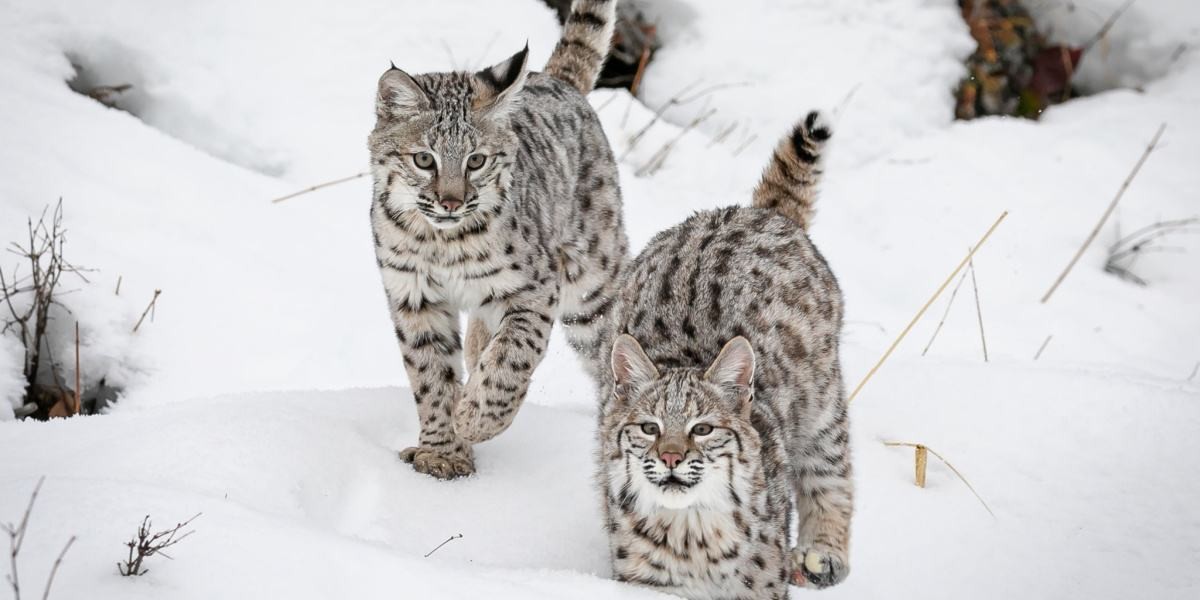
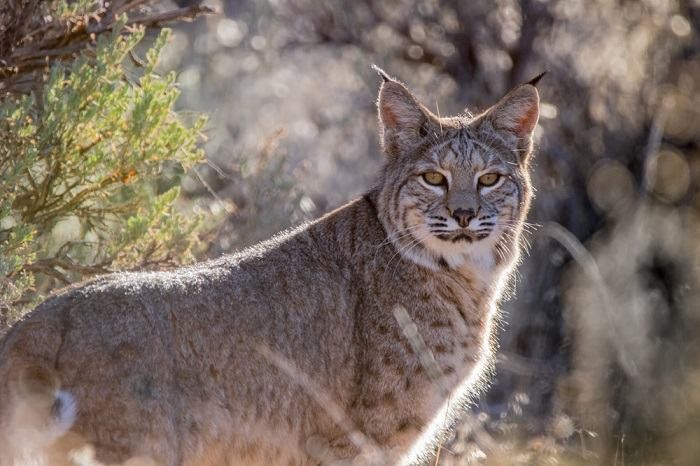
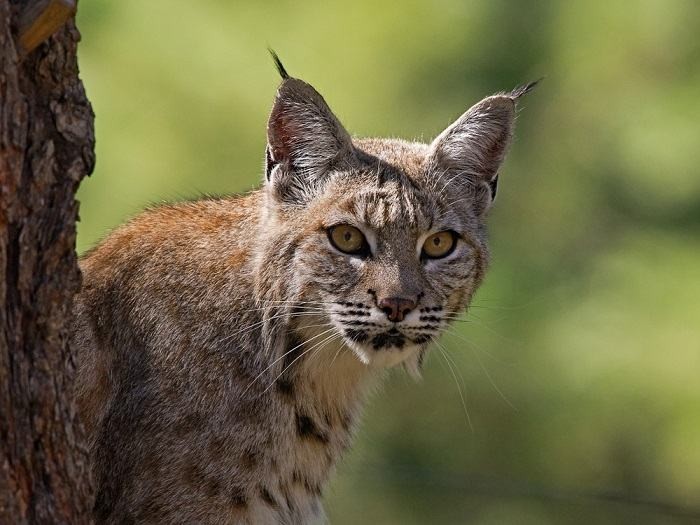
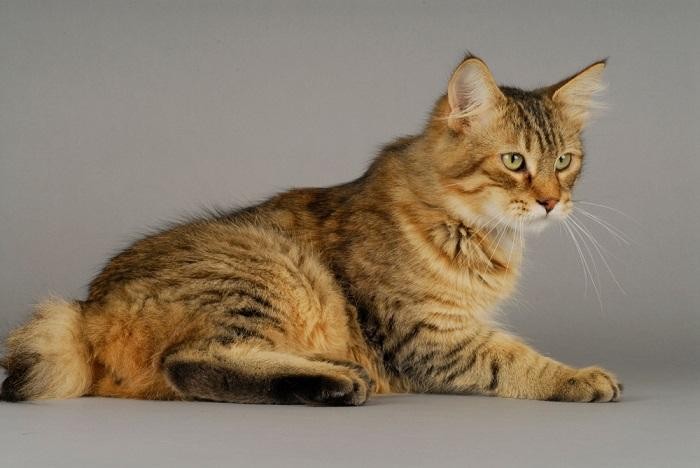
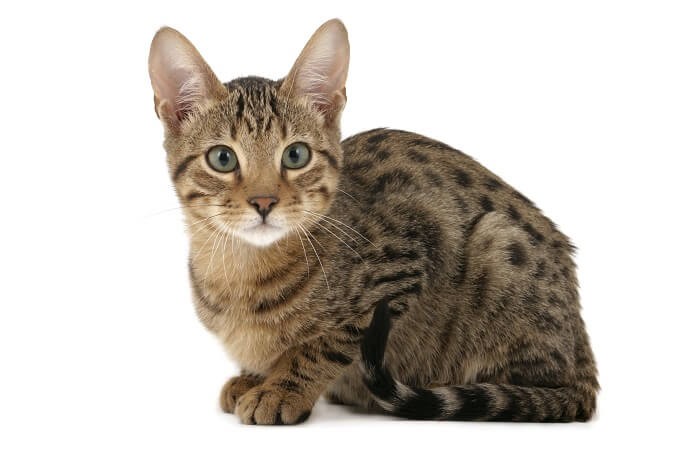
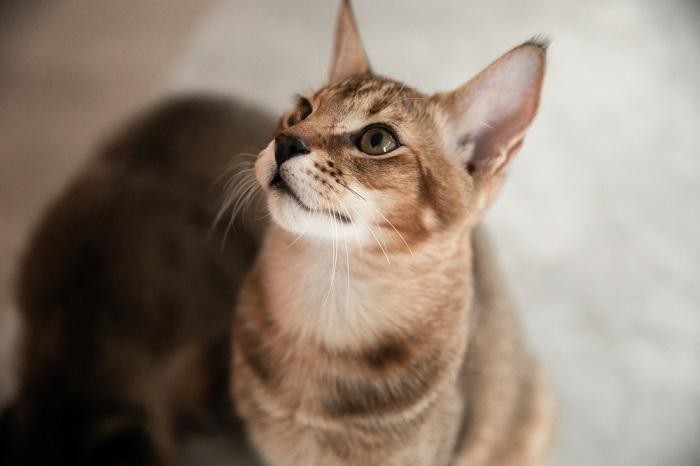
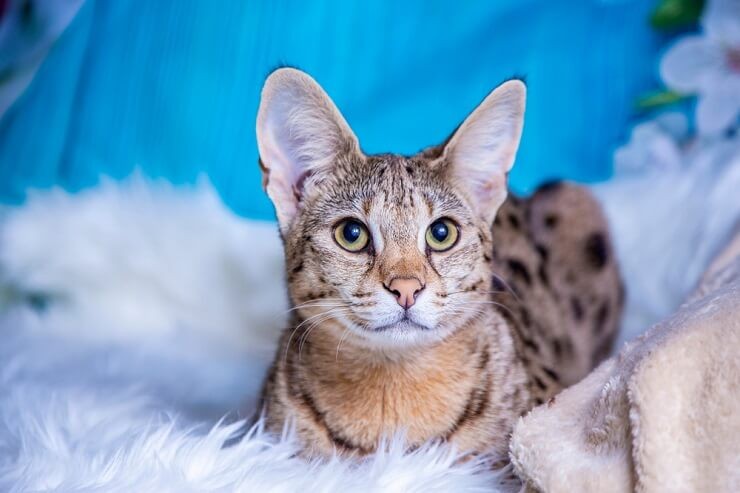
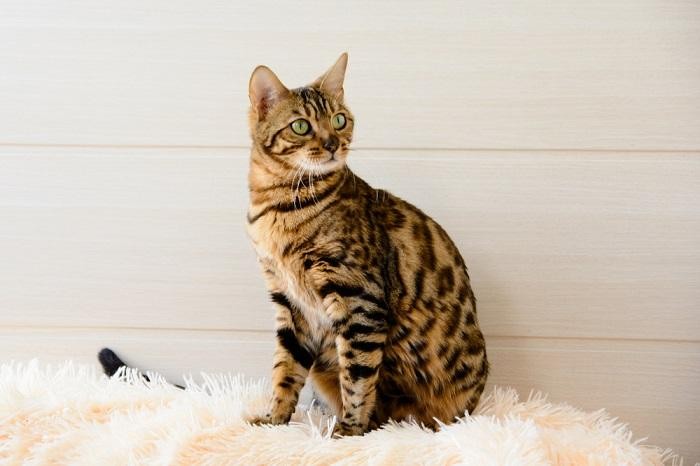
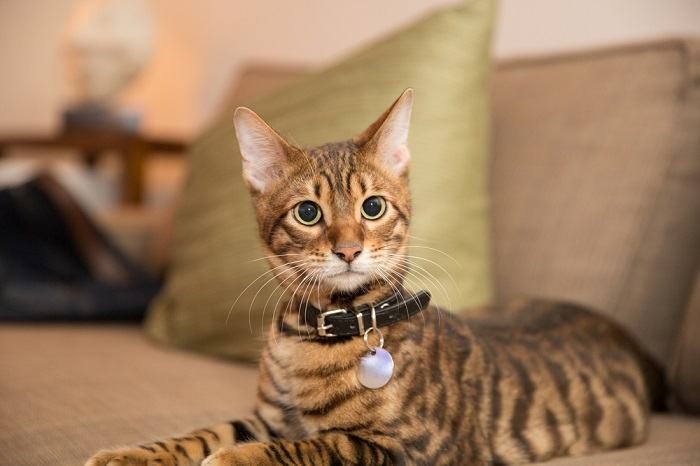
6.2. Serengeti
The Serengeti was created to resemble the wild African serval, but it contains very little wild blood. This breed was developed using Bengals and Oriental Shorthairs. The small amount of wild cat blood comes from the Bengal, which originated from the Asian leopard cat.
Serengetis are confident, friendly, and enjoy following their owners around the house. They are active, love to run and climb, and are very talkative.
Serengeti Breed Overview
| Feature | Details |
|---|---|
| Origin | United States |
| Height | 8″- 10″ |
| Adult Weight | 8-15 pounds |
| Life Span | 8-12 years |
| Group | Medium-sized short-haired |
| Price | $600 – $2,000 |
6.3. Chausie
The Chausie (pronounced chow-see) is a hybrid breed created in the 1990s by breeding jungle cats and domestic cats. The jungle cat (Felis chaus) is a small wild cat with sandy, reddish-brown, or gray fur.
Chausies come in three color patterns: brown-ticked tabby, solid black, and grizzled tabby, a unique color pattern inherited from the jungle cat. These cats are active, athletic, playful, sociable, and affectionate.
Chausie Breed Overview
| Feature | Details |
|---|---|
| Origin | Egypt, South Asia |
| Height | 14″-18″ |
| Adult Weight | 12-25 pounds |
| Life Span | 10-15 years |
| Group | Large short-haired |
| Price | $500-$2500 |
6.4. Savannah
The Savannah is a hybrid breed developed by crossing African servals and domestic cats. The serval (Leptailurus serval) is a small wild cat native to Africa with a slender body, small head, and large ears.
Savannahs are curious, outgoing, and assertive. They enjoy playing in water and require ample exercise and mental stimulation.
Savannah Breed Overview
| Feature | Details |
|---|---|
| Origin | United States |
| Height | 10″- 13″ |
| Adult Weight | 9-15 pounds |
| Life Span | 12-15 years |
| Group | Large-sized short-haired |
| Price | $1,500 – $25,000 (depending on generation) |
6.5. Bengal
The Bengal is another hybrid breed created by breeding domestic cats with the Asian leopard cat (Prionailurus bengalensis). This breed inherited its beautiful coat pattern, unique among domestic cats, from its wild ancestor.
Some Bengals have special spots called rosettes, similar to the markings found on leopards, jaguars, and ocelots. Bengals are active, confident, curious, and affectionate with their human families.
Bengal Breed Overview
| Feature | Details |
|---|---|
| Origin | United States |
| Height | 13″-16″ |
| Adult Weight | 6-15 pounds |
| Life Span | 12-20 years |
| Group | Large shorthair |
| Price | $1,500 – $3,000 |
6.6. Toyger
The Toyger was created to resemble a miniature tiger, but it has very little wild blood. This breed was developed using a domestic cat, a Bengal, and a street cat from India. The result is a cat with a bold, vertical-striped pattern and circular markings on the head, similar to a tiger.
The small amount of wild cat blood in the Toyger comes from the Bengal, which originated from the Asian leopard cat. Toygers are laid-back, intelligent, and easily trained. They love people and are exceptionally friendly.
Toyger Breed Overview
| Feature | Details |
|---|---|
| Origin | United States |
| Height | 8″- 10″ |
| Adult Weight | 7-15 pounds |
| Life Span | 12-15 years |
| Group | Medium-sized short-haired |
| Price | $1200 – $3000 |
7. Exploring Further on PETS.EDU.VN
At PETS.EDU.VN, we understand the challenges pet owners face in finding reliable information and services. From nutrition and health to behavior and training, our goal is to provide comprehensive and accessible guidance for pet lovers worldwide.
7.1. Addressing Customer Challenges
- Information Overload: We curate accurate, easy-to-understand content on caring for various pets.
- Conflicting Advice: Our experts offer clear, consistent advice on pet nutrition and health.
- Behavioral Concerns: We provide solutions for addressing common pet behavioral issues.
- Service Discovery: We connect you with reputable pet care services in your area.
- Understanding Pet Needs: We offer in-depth insights into the unique needs of different pet species.
7.2. Services Offered by PETS.EDU.VN
- Comprehensive Care Guides: Detailed information on caring for a wide range of pets.
- Expert Q&A: Answers to your questions about pet nutrition, health, and behavior.
- Effective Training Tips: Guidance on training and interacting with your pet effectively.
- Trusted Service Directory: A curated list of reputable pet care services, including veterinary clinics and spas.
- Breed Insights: Comprehensive information on popular and unique pet breeds.
8. Ethical Considerations and Conservation
PETS.EDU.VN advocates for responsible pet ownership and wildlife conservation. Owning exotic animals like bobcats can contribute to their exploitation and endangerment. By choosing domestic breeds that mimic the wild look, you support ethical breeding practices and help protect wild populations.
9. Key Considerations Before Choosing a Pet
Before bringing any pet into your home, consider the following:
- Lifestyle Compatibility: Does your lifestyle align with the needs of the pet?
- Financial Commitment: Can you afford the costs of food, healthcare, and other necessities?
- Legal Requirements: Are there any local laws or regulations regarding pet ownership?
- Ethical Implications: Is it ethical to keep a particular animal as a pet?
PETS.EDU.VN is committed to helping you make informed decisions that benefit both you and your future pet.
10. Frequently Asked Questions About Bobcats as Pets
Here are some frequently asked questions about bobcats and their suitability as pets:
10.1. Can a bobcat be tamed?
Taming a bobcat typically involves rescuing a young kitten and providing care and socialization. While these bobcats might learn to live with humans, they remain wild felines with unpredictable and potentially dangerous behavior. Wildlife experts do not recommend taming bobcats.
10.2. Will a bobcat attack a person?
Wild bobcat attacks on humans are extremely rare. Bobcats generally avoid humans, and their first instinct is to run if they encounter one. However, any wild animal can be dangerous if cornered.
10.3. Can a bobcat mate with a domestic cat?
Although bobcats and domestic cats can mate, there are no documented offspring between them, suggesting that they likely cannot interbreed.
10.4. Are bobcats difficult to care for?
Exotic animals like bobcats are very difficult to care for. They are territorial, messy, and exhibit behaviors like urine spraying and scratching. They also require specialized diets, which can be expensive and hard to obtain. Finding a veterinarian willing to treat a wild animal like a bobcat can also be challenging.
10.5. What are the specific dietary needs of a bobcat compared to a domestic cat?
Bobcats require a diet that is high in protein and includes raw meat, bones, and organs, which is significantly different from the commercially prepared diets for domestic cats.
10.6. What are the potential legal consequences of owning a bobcat in different states?
The legal consequences can range from hefty fines and confiscation of the animal to potential jail time, depending on the state and local regulations.
10.7. How do hybrid breeds like Bengals and Savannahs compare to bobcats in terms of temperament and care requirements?
Hybrid breeds like Bengals and Savannahs are generally more socialized and have temperaments more suited to domestic life. Their care requirements are similar to those of domestic cats, though they may require more exercise and mental stimulation.
10.8. What kind of enrichment activities are necessary for a bobcat in captivity to prevent behavioral problems?
Enrichment activities for a bobcat in captivity would need to mimic their natural behaviors, such as hunting, climbing, and exploring. This could include large, secure enclosures with climbing structures, puzzle feeders, and opportunities for scent marking.
10.9. How does keeping a bobcat as a pet impact conservation efforts for the species?
Keeping bobcats as pets can negatively impact conservation efforts by removing individuals from the wild population and potentially contributing to the illegal wildlife trade.
10.10. What are the long-term health risks associated with keeping a bobcat in a domestic environment?
Long-term health risks can include obesity due to lack of adequate exercise, stress-related illnesses, and nutritional deficiencies if their diet is not properly managed.
Conclusion: Prioritizing Safety and Ethical Pet Ownership
While the allure of owning a bobcat might be strong, it’s essential to recognize the inherent dangers, ethical considerations, and legal implications. By choosing domestic breeds that resemble wild cats, you can enjoy an exotic aesthetic without compromising safety or contributing to the exploitation of wildlife.
At PETS.EDU.VN, we encourage responsible pet ownership and provide the resources you need to make informed decisions. Explore our website for more information on various pet breeds, care tips, and expert advice.
Ready to find the perfect feline companion? Visit pets.edu.vn today to explore our comprehensive guides and resources! Contact us at 789 Paw Lane, Petville, CA 91234, United States, or Whatsapp: +1 555-987-6543. Your journey to responsible pet ownership starts here.
